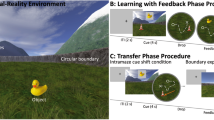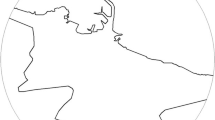Abstract
Decline of hippocampal function with age has many effects, including deficits in episodic memory and spatial orientation. Motivated by research in cognitive psychology and behavioral neuroscience showing the importance of environmental boundaries in spatial mapping, we tested adult and aged rats in a simple reorientation task involving both environmental boundary geometry and landmarks. We find preliminary evidence that aged rats are impaired in their ability to reorient, particularly with respect to boundary geometry.
Access provided by CONRICYT-eBooks. Download conference paper PDF
Similar content being viewed by others
Keywords
1 Introduction
Animals can apply various strategies in finding their way towards a target location. To do so they use information from the external environment to create an internal spatial representation to facilitate their navigation. In a controlled laboratory setup, animals can be tested on their use of two main kinds of cues: the geometric properties of the environment, such as the arena shape, or landmark features such as visual colors and patterns. Several studies have shown that a wide range of animal species, including humans, use environmental geometry to encode and find their way to a goal location (Cheng 1986; Hermer and Spelke 1994; Lee et al. 2012). The neural substrates of spatial mapping and navigation are said to be in the hippocampal formation. Particular spatially specific neurons such as place cells, grid cells, head direction and boundary cells provide the representations that make up an internal map in the animal’s brain (Hartley et al. 2014). Out of these cells, the boundary cells have been shown to play a crucial role in defining a location with respect to the environment (Hartley et al. 2000; Lever et al. 2009).
2 Methods
Given the marked changes in hippocampal function with aging, we tested fourteen Lister hooded rats (Rattus Norvegicus) at the age of 6 months (adults) and seventeen at the age of 18 months (old) in a working memory task. We trained animals in each trial to explore the arena and find the rewarded corner that contained pieces of chocolate. The animal was then removed, disoriented, and placed back in the empty arena for a one-minute testing period. Each animal received three trials per day for two consecutive days. We later observed the time they spent in each corner. We applied this task in three different environmental conditions: a black rectangular arena, a rectangular arena with a striped wall and a square arena with a striped wall.
3 Results
Young adult rats (n = 5) in a rectangular arena spend more time in the correct and rotationally correct corners showing successful use of geometry. However, old rats (n = 7) in the same condition show clearly no distinction between correct and incorrect corners (Fig. 1).
The introduction of a striped wall helps searches toward the correct corner in both groups (n = 4 young; n = 6 old) showing that a salient cue like a striped wall coupled with landmark help in reorientation towards the target location (Fig. 2).
Rectangular arena (120 × 60 cm) to test the use of boundary geometry and landmark use such as a striped wall (0.5 cm thick polyurethane panels alternating black and white stripes thick 10 cm). The bars indicate the proportion of time they spend in a 2 cm range from each corner during the 60 s testing
In the last condition both young and old rats (n = 5 young; n = 4 old) do not show a statistical preference towards the correct corner showing difficulty in landmark use alone (Fig. 3).
4 Discussion
Our findings suggest that age can alter some of our cognitive abilities such as our ability to reorient in a simple spatial environment. This is consistent with the idea that our brain and specific brain structures such as the hippocampus involved in spatial navigation face physiological changes with age and consequently result in impairments on such tasks. Being able to assess hippocampal, function in spatial cognition using simple noninvasive behavioral tests can benefit patients and better evaluate the cognitive effects of treatments. This is of particular importance in disorders such as Alzheimer’s disease, in which early diagnosis is crucial.
References
Cheng K (1986) A purely geometric module in the rat’s spatial representation. Cognition 23(2):149–178
Hartley T, Burgess N, Lever C, Cacucci F, O’Keefe J (2000) Modeling place fields in terms of the cortical inputs to the hippocampus. Hippocampus 10(4):369–379
Hartley T, Lever C, Burgess N, O’Keefe J (2014) Space in the brain: how the hippocampal formation supports spatial cognition. Phillos Trans R Soc B 369(1635):20120510
Hermer L, Spelke ES (1994) A geometric process for spatial reorientation in young children. Nature 370(6484):57
Lee SA, Spelke ES, Vallortigara G (2012) Chicks, like children, spontaneously reorient by three-dimensional environmental geometry, not by image matching. Biol Lett p.rsbl20120067
Lever C, Burton S, Jeewajee A, O’Keefe J, Burgess N (2009) Boundary vector cells in the subiculum of the hippocampal formation. J Neurosci 29(31):9771–9777
Author information
Authors and Affiliations
Corresponding author
Editor information
Editors and Affiliations
Rights and permissions
Copyright information
© 2018 Springer International Publishing AG
About this paper
Cite this paper
Bhushan, R., Colombari, E., Lee, S.A. (2018). Boundary Based Navigation Is Impaired in Old Age. In: Fogliaroni, P., Ballatore, A., Clementini, E. (eds) Proceedings of Workshops and Posters at the 13th International Conference on Spatial Information Theory (COSIT 2017). COSIT 2017. Lecture Notes in Geoinformation and Cartography. Springer, Cham. https://doi.org/10.1007/978-3-319-63946-8_4
Download citation
DOI: https://doi.org/10.1007/978-3-319-63946-8_4
Published:
Publisher Name: Springer, Cham
Print ISBN: 978-3-319-63945-1
Online ISBN: 978-3-319-63946-8
eBook Packages: Earth and Environmental ScienceEarth and Environmental Science (R0)







